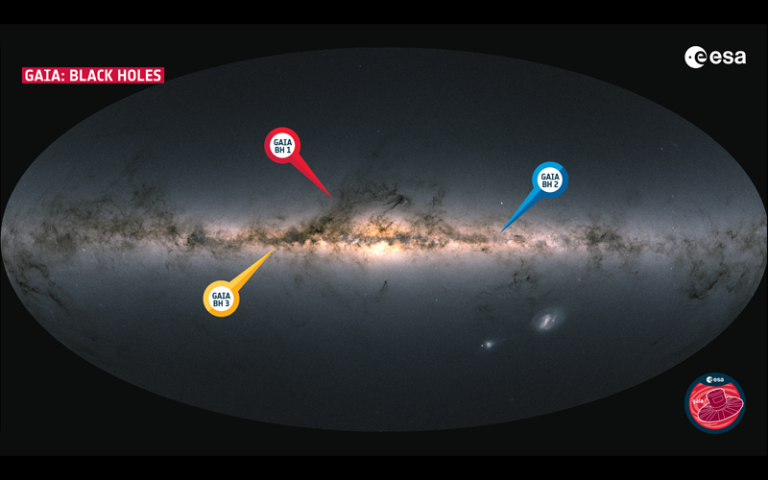Large dormant black hole spotted in our galaxy
16 April 2024
The European Space Agency’s Gaia mission involving UCL researchers has discovered the most massive black hole in our galaxy to date that formed from an exploding star.

The black hole, known as Gaia BH3, is 33 times the mass of our Sun and located relatively close to Earth at 2,000 light years away. (The Milky Way is 100,000 light years across.)
The only black hole known to be more massive in our galaxy is the supermassive black hole at its centre which could not have been born from the collapse of a single exploding star and whose formation is tied to the formation of the Milky Way itself.
Gaia BH3 was not seen directly but inferred from the movements of what appeared to be a lone star now understood to be the black hole’s companion, i.e., gravitationally bound to the black hole and orbiting around a common point.
Most known black holes are active – that is, they gobble matter from a nearby star companion. Gaia BH3 is a dormant black hole as it does not have a companion close enough to steal matter from and does not generate any light. It is therefore much harder to spot.
Currently, there are about 50 confirmed or suspected black holes in our galaxy, but theory predicts there is a hidden population of thousands or millions, due to the number of stars that have likely already died over the galaxy’s lifetime.
Dr George Seabroke (Mullard Space Science Laboratory at UCL), a member of Gaia’s Black Hole Task Force, the team that made the discovery, said: “Finding Gaia BH3 is like the moment in the film The Matrix where Neo starts to ‘see’ the matrix. In our case, ‘the matrix’ is our galaxy’s population of dormant stellar black holes, which were hidden from us before Gaia detected them.
“Gaia BH3 is an important clue to this population because it is the most massive stellar black hole found in our galaxy. Gaia’s next data release is expected to contain many more, which should help us to ‘see’ more of ‘the matrix’ and to understand how dormant stellar black holes form.”
Lead author Dr Pasquale Panuzzo of CNRS, Observatoire de Paris, in France, said: “It's a real unicorn. This is the kind of discovery you make once in your research life. So far, black holes this big have only ever been detected in distant galaxies, by the LIGO–Virgo–KAGRA collaboration thanks to observations of gravitational waves.”
Professor Tsevi Mazeh of Tel Aviv University in Israel, who is a member of the Gaia collaboration, said: “Gaia BH3 is the very first black hole for which we could measure the mass so accurately,” remarks “At 30 times that of our Sun, the object’s mass is typical of the estimates we have for the masses of the very distant black holes observed by gravitational wave experiments. Gaia’s measurements provide the first undisputable proof that black holes this heavy do exist.”
The discovery also provides a clue to the puzzle of how black holes this massive form. Our current understanding of how massive stars evolve and die does not immediately explain how these types of black holes came to be.
The star orbiting Gaia BH3 has very few elements heavier than hydrogen and helium, indicating that the massive star that became Gaia BH3 could also have been very poor in heavy elements.
The star orbiting Gaia BH3 at about 16 times the Sun–Earth distance is rather uncommon: an ancient giant star, that formed in the first two billion years after the Big Bang, at the time our galaxy started to assemble. It belongs to the family of the Galactic stellar halo and is moving in the opposite direction to the stars of the Galactic disc. Its trajectory indicates that this star was probably part of a small galaxy, or a globular cluster, engulfed by our own galaxy more than eight billion years ago.
At the widest point of its orbit, the star is as far away from Gaia BH3 as Neptune is from the Sun. At its closest, it is about the distance of Jupiter from the Sun.
UCL Mullard Space Science Laboratory has contributed significantly to Gaia over more than 20 years by developing Gaia spectrometer concepts, testing and calibrating each of the 106 electronic detectors used to capture all of Gaia’s data, and by taking a major role in the spectroscopic data processing.
The UK team involved in the Gaia mission is supported by the UK Space Agency and the Science and Technology Facilities Council.
The findings will be published in a new paper in the journal Astronomy & Astrophysics.
Links
- The paper in the journal Astronomy & Astrophysics
- Dr George Seabroke’s academic profile
- Mullard Space Science Laboratory at UCL
- UCL Mathematical & Physical Sciences
- ESA Gaia space mission
Image
- On this sky map, Gaia’s three black holes are shown at their respective locations on the sky. Gaia BH1 was found in 2022 following Gaia’s Data Release 3, a catalogue based on 34 months of Gaia data. It is the closest black hole to Earth at ~1560 light years away. Gaia BH2 was found in 2023, also using Gaia’s data release 3. At the time of its discovery, it was the second closest black hole to Earth at ~3800 light years away. Gaia BH3 was found during the validation of Gaia’s preliminary data while preparing for Gaia Data Release 4, a catalogue that will be based on 66 months of Gaia data. Gaia BH3 is located at ~1900 light years away, which makes it the second closest black hole known today. Credits: ESA/Gaia/DPAC. License: CC BY-SA 3.0 IGO
Source
Media contact
Mark Greaves
T: +44 (0)7990 675947
E: m.greaves [at] ucl.ac.uk
 Close
Close

